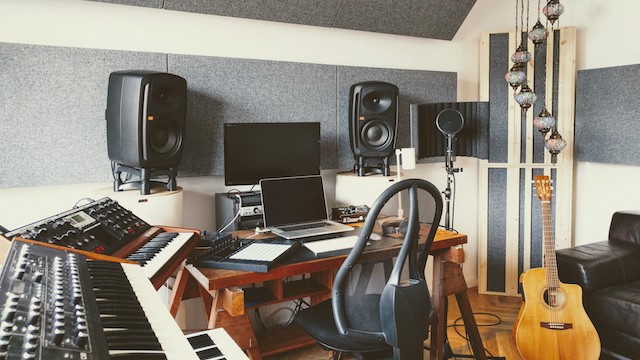hutt132
Member
- Joined
- Jul 25, 2019
- Messages
- 57
- Likes
- 87
The sound system is 7.2.4 surround. All the speakers are from Ascend Acoustics and the subwoofers are Monoprice Monolith 15in 1000w.
Listening position is 60 in. from rear wall, so nearly at the 2/3 point in the room.
Canopy panels - 4" rockwool, which I mainly put up to absorb light bounce from the ceiling above the screen. Sadly I didn't take before and after freq measurements.
Blackout curtains - (heavy, double layered blackout) on the two right wall windows and the same curtains on the left wall to cover the entrance/wall to the kitchen.
Black rug - 3/8" thick felt underlayment under it. The red rug is thick.
I was planning to build a large rear wall panel with 4" Rockboard 60.
The green line REW measurement is of the front LR speakers (no subwoofers) from the center couch position at ear level.
The red line is with a 3" 80x60in gel foam mattress topper on the rear wall behind the shelf to test what I could expect from rear sound panel I've been planning.
(The topper only went up 60" from the floor, whereas the rear panel I'm planning goes to the top of the projector 108" up.)
The white line is the estimated in-room response of the speakers as published by Ascend Acoustics.
There's some gnarly nulls and peaks below 300 Hz, but above that it stays mostly compliant with the estimated speaker response.
I can't figure why the mattress topper made the 330 Hz and 530 Hz dips worse, while only slightly improving the nulls in the lower frequencies and not lowering the peaks at all.
I also added 3.5 in. x 15 in. x 47 in. rockwool on the wall directly behind the speakers between the screen and the shelves as a test for comb filtering and it didn't change the frequency response at all.
Any insight would be much appreciated to fix the nulls around 155-150Hz, 120Hz, 89Hz, and 72Hz.
L+R REW Measurements (no subwoofers)



Rendering of planned rear panel

- Front LR - SIERRA-2EX V2
- Center - ELX HORIZON
- Surrounds/Heights - HTM-200SE
Listening position is 60 in. from rear wall, so nearly at the 2/3 point in the room.
Canopy panels - 4" rockwool, which I mainly put up to absorb light bounce from the ceiling above the screen. Sadly I didn't take before and after freq measurements.
Blackout curtains - (heavy, double layered blackout) on the two right wall windows and the same curtains on the left wall to cover the entrance/wall to the kitchen.
Black rug - 3/8" thick felt underlayment under it. The red rug is thick.
I was planning to build a large rear wall panel with 4" Rockboard 60.
The green line REW measurement is of the front LR speakers (no subwoofers) from the center couch position at ear level.
The red line is with a 3" 80x60in gel foam mattress topper on the rear wall behind the shelf to test what I could expect from rear sound panel I've been planning.
(The topper only went up 60" from the floor, whereas the rear panel I'm planning goes to the top of the projector 108" up.)
The white line is the estimated in-room response of the speakers as published by Ascend Acoustics.
There's some gnarly nulls and peaks below 300 Hz, but above that it stays mostly compliant with the estimated speaker response.
I can't figure why the mattress topper made the 330 Hz and 530 Hz dips worse, while only slightly improving the nulls in the lower frequencies and not lowering the peaks at all.
I also added 3.5 in. x 15 in. x 47 in. rockwool on the wall directly behind the speakers between the screen and the shelves as a test for comb filtering and it didn't change the frequency response at all.
Any insight would be much appreciated to fix the nulls around 155-150Hz, 120Hz, 89Hz, and 72Hz.
L+R REW Measurements (no subwoofers)
Rendering of planned rear panel
Last edited:



